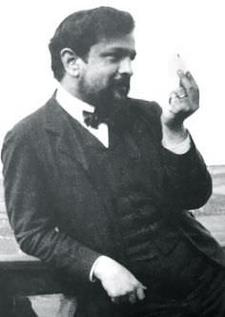Impressionism in music facts for kids
Impressionism in music was a special style of classical music. It was popular with composers mainly in the late 1800s and early 1900s. This music focuses on creating a certain mood or feeling. It tries to show the emotions a topic brings out, rather than a clear picture.
The word "Impressionism" comes from a style of French painting. These painters, like Claude Monet, used bright colors and blurry details. Their goal was to make you focus on the overall "impression" of a scene. In music, composers did something similar. They used musical "colors" to create a feeling.
Musical "color" means the unique sound of different instruments. This is also called timbre. Composers used new ways to combine sounds and harmonies. They also used special scales and chords. This helped them create a dream-like or misty sound. Titles for these pieces often sounded like paintings, such as "Reflections on the Water."
Contents
Famous Impressionist Composers
Two of the most important composers in Impressionism were Claude Debussy and Maurice Ravel. Even though they were leaders, Debussy didn't like the "Impressionism" label. He felt it was used incorrectly. Ravel also wasn't comfortable with the term.
Debussy's Impressionist music often creates a mood or scene. He used special musical ideas, harmonies, and unique scales. These scales included the whole-tone and pentatonic scales. He also used large, rich chords and made instruments sound very colorful. Debussy's music is known for being subtle and nuanced.
In 1912, a French composer named Ernest Fanelli gained attention. He wrote a piece called Thèbes in 1886. It had some elements that sounded like Impressionism. However, Ravel thought these ideas had been used before by other composers.
Other Composers
Many other composers are also linked to Impressionism. These include Lili Boulanger, Isaac Albéniz, and Frederick Delius. Others are Paul Dukas, Alexander Scriabin, and Manuel de Falla.
The Finnish composer Jean Sibelius is also connected to this style. His piece The Swan of Tuonela was written in 1893. This was even before Debussy's Prélude à l'après-midi d'un faune. Debussy's piece is often seen as a very important Impressionist work.
What Makes Impressionist Music Special?
Impressionist music uses harmony in a new way. Harmony is when different notes are played at the same time. In this style, chords that sound "dissonant" (like they need to resolve) were not always resolved. Instead, they were used just for their unique sound or "timbre." These chords were often moved around in a parallel way.
For melodies, composers used special scales. These included the whole-tone scale and the pentatonic scale. Melodies often moved in a circular, flowing way. The sound of the instruments became very important. It was more important than clear themes or traditional song structures.
See also
 In Spanish: Impresionismo musical para niños
In Spanish: Impresionismo musical para niños


